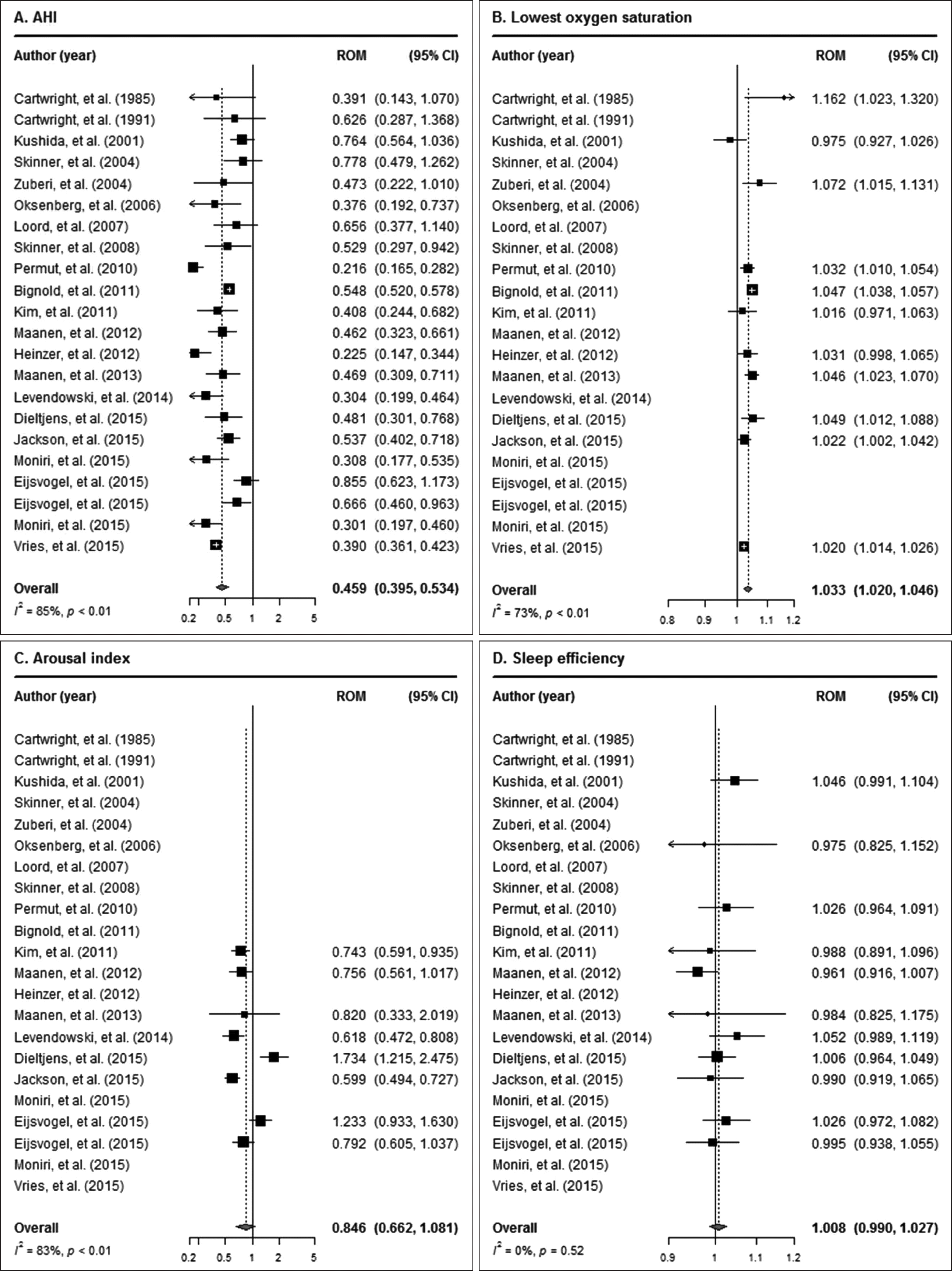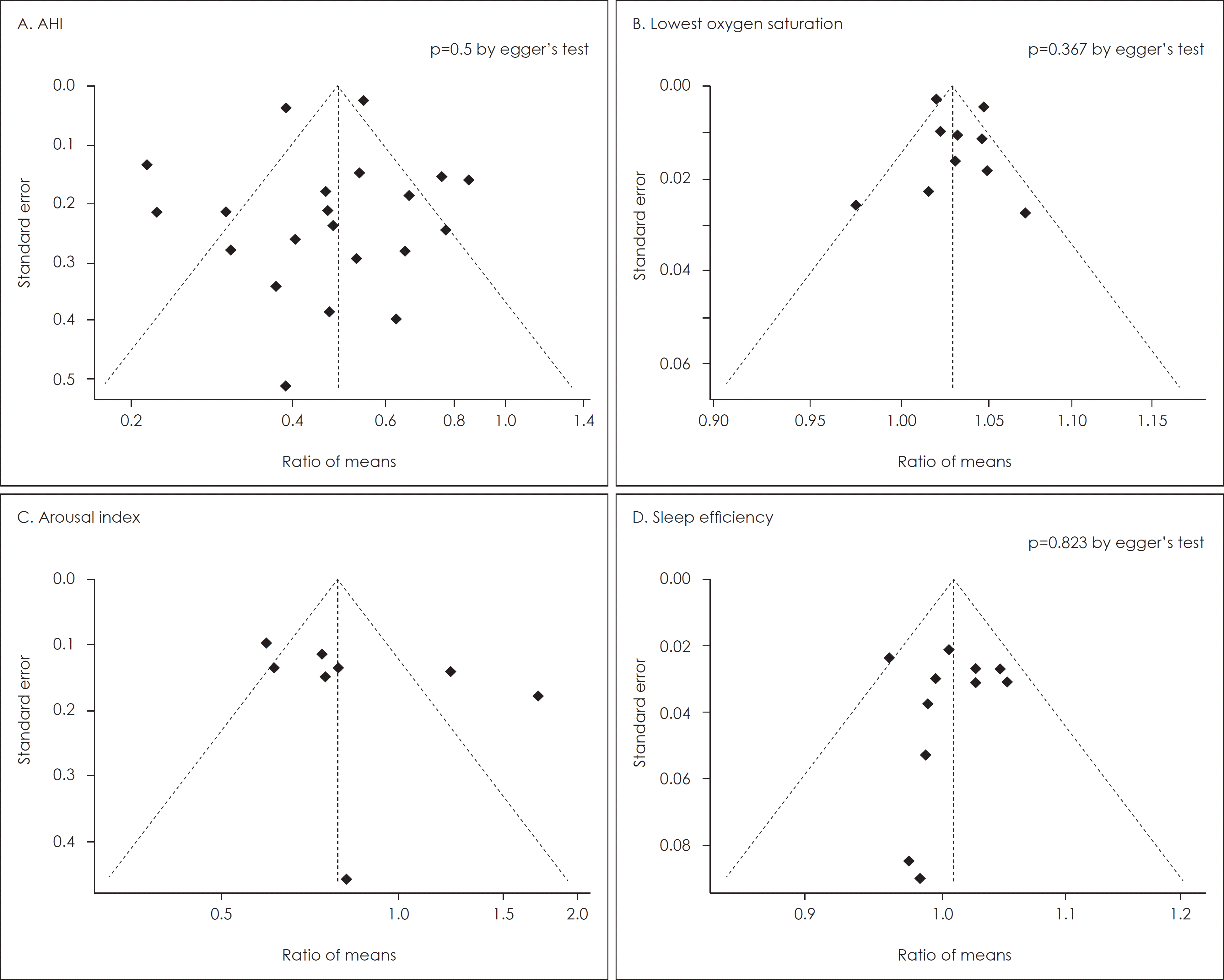Abstract
Background and Objectives:
Positional therapy is a therapeutic method for obstructive sleep apnea (OSA). However, little is known about the effectiveness of positional OSA treatment based on meta-analysis. Therefore, we undertook a review and meta-analysis of studies to assess the effect of positional therapy on OSA. Subjects and Method: We searched PubMed (Medline), OVID Medline, EMBASE, Cochrane Library, SCOPUS, Kore-aMed, MedRIC, and KSI KISS using the key words “obstructive sleep apnea” and “positional therapy”. To estimate the effect of positional OSA therapy, we analyzed the ratio of means (ROM) for pre- and post-treatment polysomnographic data including apnea-hypopnea index (AHI), lowest oxygen saturation, arousal index, and sleep efficiency.
Results:
Finally, twenty two studies from 21 papers were included in the meta-analysis. Positional therapy significantly de-creased AHI by 54.1% [ROM, 0.459; 95% confidence interval (CI), 0.394 to 0.534] and increased lowest oxygen saturation by 3.3% (ROM, 1.033; 95% CI, 1.020 to 1.046). However, positional therapy did not significantly change arousal index (ROM, 0.846; 95% CI, 0.662 to 1.081) or sleep efficiency (ROM, 1.008; 95% CI, 0.990 to 1.027).
REFERENCES
1). Epstein LJ, Kristo D, Strollo PJ Jr, Friedman N, Malhotra A, Patil SP, et al. Clinical guideline for the evaluation, management and long-term care of obstructive sleep apnea in adults. J Clin Sleep Med. 2009; 5:263–76.
2). American Academy of Sleep Medicine. International classification of sleep disorders. 3rd ed.Darien, IL: American Academy of Sleep Medicine;2014.
3). Shamsuzzaman AS, Gersh BJ, Somers VK. Obstructive sleep apnea: implications for cardiac and vascular disease. JAMA. 2003; 290:1906–14.
4). Wang JH, Kim YR, Jang YJ, Lee BJ, Chung YS. Compliance of au-to-adjusting positive airway pressure in Korean obstructive sleep apnea patients. J Rhinol. 2006; 13:92–6.
5). Choi JH, Cho JH. Effect of palatal implants on snoring and obstructive sleep apnea syndrome. J Rhinol. 2011; 18:89–93.
6). Oksenberg A, Silverberg DS. The effect of body posture on sleep-re-lated breathing disorders: facts and therapeutic implications. Sleep Med Rev. 1998; 2:139–62.

8). Oksenberg A, Silverberg DS, Arons E, Radwan H. Positional vs non-positional obstructive sleep apnea patients: anthropomorphic, noc-turnal polysomnographic, and multiple sleep latency test data. Chest. 1997; 112:629–39.
9). Morgan TD. Novel Approaches to the Management of Sleep-Disor-dered Breathing. Sleep Med Clin. 2016; 11:173–87.

10). Choi JH, Park YH, Hong JH, Kim SJ, Park DS, Miyazaki S, et al. Efficacy study of a vest-type device for positional therapy in position dependent snorers. Sleep Biol Rhythms. 2009; 7:181–7.

11). Caples SM, Rowley JA, Prinsell JR, Pallanch JF, Elamin MB, Katz SG, et al. Surgical modifications of the upper airway for obstructive sleep apnea in adults: a systematic review and meta-analysis. Sleep. 2010; 33:1396–407.

12). Cochrane Group: Cochrane handbook for systematic reviews of in-terventions-Version 5.1. 2012. Available from URL. http://www.co-chrane-handbook.org/.
13). Cartwright RD, Lloyd S, Lilie J, Kravitz H. Sleep position training as treatment for sleep apnea syndrome: a preliminary study. Sleep. 1985; 8:87–94.

14). Cartwright R, Ristanovic R, Diaz F, Caldarelli D, Alder G. A comparative study of treatments for positional sleep apnea. Sleep. 1991; 14:546–52.

15). Kushida CA, Sherrill CM, Hong SC, Palombini L, Hyde P, Dement WC. Cervical positioning for reduction of sleep-disordered breathing in mild-to-moderate OSAS. Sleep Breath. 2001; 5:71–8.

16). Skinner MA, Kingshott RN, Jones DR, Homan SD, Taylor DR. El-evated posture for the management of obstructive sleep apnea. Sleep Breath. 2004; 8:193–200.

17). Zuberi NA, Rekab K, Nguyen HV. Sleep apnea avoidance pillow ef-fects on obstructive sleep apnea syndrome and snoring. Sleep Breath. 2004; 8:201–7.

18). Oksenberg A, Silverberg D, Offenbach D, Arons E. Positional therapy for obstructive sleep apnea patients: A 6-month follow-up study. Laryngoscope. 2006; 116:1995–2000.

19). Loord H, Hultcrantz E. Positioner–a method for preventing sleep apnea. Acta Otolaryngol. 2007; 127:861–8.

20). Skinner MA, Kingshott RN, Filsell S, Taylor DR. Efficacy of the ‘tennis ball technique' versus nCPAP in the management of posi-tion-dependent obstructive sleep apnoea syndrome. Respirology. 2008; 13:708–15.

21). Permut I, Diaz-Abad M, Chatila W, Crocetti J, Gaughan JP, D'Alonzo GE, et al. Comparison of positional therapy to CPAP in patients with positional obstructive sleep apnea. J Clin Sleep Med. 2010; 6:238–43.

22). Bignold JJ, Mercer JD, Antic NA, McEvoy RD, Catcheside PG. Ac-curate position monitoring and improved supine-dependent obstructive sleep apnea with a new position recording and supine avoidance device. J Clin Sleep Med. 2011; 7:376–83.

23). Kim SJ, Choi JH, Park YH, Hong JH, Park DS, Lee SH, et al. Positional therapy for the reduction of obstructive sleep apnea. Sleep Biol Rhythms. 2011; 9:150–6.

24). van Maanen JP, Richard W, Van Kesteren ER, Ravesloot MJ, Laman DM, Hilgevoord AA, et al. Evaluation of a new simple treatment for positional sleep apnoea patients. J Sleep Res. 2012; 21:322–9.

25). Heinzer RC, Pellaton C, Rey V, Rossetti AO, Lecciso G, Haba-Rubio J, et al. Positional therapy for obstructive sleep apnea: an objective measurement of patients' usage and efficacy at home. Sleep Med. 2012; 13:425–8.

26). van Maanen JP, Meester KA, Dun LN, Koutsourelakis I, Witte BI, Laman DM, Hilgevoord AA, de Vries N. The sleep position trainer: a new treatment for positional obstructive sleep apnoea. Sleep Breath. 2013; 17:771–9.

27). Levendowski DJ, Seagraves S, Popovic D, Westbrook PR. Assess-ment of a neck-based treatment and monitoring device for positional obstructive sleep apnea. J Clin Sleep Med. 2014; 10:863–71.

28). Dieltjens M, Vroegop AV, Verbruggen AE, Wouters K, Willemen M, De Backer WA, et al. A promising concept of combination therapy for positional obstructive sleep apnea. Sleep Breath. 2015; 19:637–44.

29). Jackson M, Collins A, Berlowitz D, Howard M, O'Donoghue F, Barnes M. Efficacy of sleep position modification to treat positional obstructive sleep apnea. Sleep Med. 2015; 16:545–52.

30). Bidarian-Moniri A, Nilsson M, Attia J, Ejnell H. Mattress and pillow for prone positioning for treatment of obstructive sleep apnoea. Acta Otolaryngol. 2015; 135:271–6.

31). Eijsvogel MM, Ubbink R, Dekker J, Oppersma E, de Jongh FH, van der Palen J, et al. Sleep position trainer versus tennis ball technique in positional obstructive sleep apnea syndrome. J Clin Sleep Med. 2015; 11:139–47.

Fig. 1.
Forest plots for the effectiveness of positional therapy on respiratory and sleep parameters.

Table 1.
Characteristics of the included studies
Table 2.
Effectiveness of positional therapy on respiratory and sleep parameters
| Author ( year) | No. of samples | No. of Ratio of meanns (95% CI)∗ | |||
|---|---|---|---|---|---|
| AHI | Lowest oxygen saturation | Arousal index | Sleep efficiency | ||
| Cartwright et al. (1985) | 10 | 0.391 (0.143, 1.070) | 1.162 (1.023, 1.32) | - | - |
| Cartwright et al. (1991) | 15 | 0.626 (0.287, 1.368) | - | - | - |
| Kushida et al. (2001) | 18 | 0.764 (0.564, 1.036) | 0.975 (0.927, 1.026) | - | 1.046 (0.991, 1.104) |
| Skinner et al. (2004) | 14 | 0.778 (0.480, 1.262) | - | - | - |
| Zuberi et al. (2004) | 22 | 0.473 (0.222, 1.010) | 1.072 (1.015, 1.131) | - | - |
| Oksenberg et al. (2006) | 12 | 0.376 (0.192, 0.737) | - | - | 0.975 (0.825, 1.152) |
| Loord et al. (2007) | 18 | 0.656 (0.377, 1.140) | - | - | - |
| Skinner et al. (2008) | 20 | 0.529 (0.297, 0.942) | - | - | - |
| Permut et al. (2010) | 38 | 0.216 (0.165, 0.282) | 1.032 (1.010, 1.054) | - | 1.026 (0.964, 1.091) |
| Bignold et al. (2011) | 15 | 0.548 (0.520, 0.578) | 1.047 (1.038, 1.057) | - | - |
| Kim et al. (2011) | 14 | 0.408 (0.244, 0.682) | 1.016 (0.971, 1.063) | 0.743 (0.591, 0.935) | 0.988 (0.891, 1.096) |
| van Maanen et al. (2012) | 30 | 0.462 (0.323, 0.661) | - | 0.756 (0.561, 1.017) | 0.961 (0.916, 1.007) |
| Heinzer et al. (2012) | 16 | 0.225 (0.147, 0.344) | 1.031 (0.998, 1.065) | - | - |
| van Maanen et al. (2013) | 31 | 0.469 (0.309, 0.711) | 1.046 (1.023, 1.070) | 0.82 (0.333, 2.019) | 0.984 (0.825, 1.175) |
| Levendowski et al. (2014) | 30 | 0.304 (0.199, 0.464) | - | 0.618 (0.472, 0.808) | 1.052 (0.989, 1.119) |
| Dieltjens et al. (2015) | 19 | 0.481 (0.301, 0.768) | 1.049 (1.012, 1.088) | 1.734 (1.215, 2.475) | 1.006 (0.964, 1.049) |
| Jackson et al. (2015) | 47 | 0.537 (0.402, 0.718) | 1.022 (1.002, 1.042) | 0.599 (0.494, 0.727) | 0.990 (0.919, 1.065) |
| Bidarian-Moniri et al. (2015) | 14 | 0.308 (0.177, 0.535) | - | - | - |
| Eijsvogel et al. (2015) | 29 | 0.855 (0.623, 1.173) | - | 1.233 (0.933, 1.63) | 1.026 (0.972, 1.082) |
| Eijsvogel et al. (2015) | 26 | 0.666 (0.460, 0.963) | - | 0.792 (0.605, 1.037) | 0.995 (0.938, 1.055) |
| Bidarian-Moniri et al. (2015) | 27 | 0.301 (0.197, 0.460) | - | - | - |
| de Vries et al. (2015) | 40 | 0.390 (0.361, 0.423) | 1.020 (1.014, 1.026) | - | - |
| Overall | 505 | 0.459 (0.394, 0.534) | 1.033 (1.020, 1.046) | 0.846 (0.662, 1.081) | 1.008 (0.990, 1.027) |
| Heterogeneity-I2(%) | 85.0 (78.5, 89.5) | 73.0 (50.7, 85.3) | 82.5 (66.8, 90.8) | 0.0 (0.0, 56.4) | |
| p-value | <0.001 | <0.001 | <0.001 | 0.521 | |
Table 3.
Result of Meta-ANOVA
Table 4.
Result of Meta-regression




 PDF
PDF ePub
ePub Citation
Citation Print
Print



 XML Download
XML Download